
It’s safe to say that over the past two decades, music streaming has changed the way we listen to music forever. Music streaming services such as Spotify and Tidal have made it easier than ever to discover new artists and songs. However, choosing the right platform for your music needs can be overwhelming, given the many options available. If you’re torn between Tidal vs Spotify, well, this article is for you. Keep reading, and we’ll break down the top choices so you can find the right one for you.
Contents Guide Part 1. Basic Overview of Tidal and SpotifyPart 2. In-Depth Comparison of Tidal and SpotifyPart 3. Bonus: Listen to Spotify Offline Without PremiumPart 4. Conclusion
How do Tidal vs Spotify compare? Before making a comprehensive comparison of both services, let's have a quick look at Tidal and Spotify.
Spotify is a Swedish audio streaming and media service provider founded on 23 April 2006 by Daniel Ek and Martin Lorentzon. It leads the streaming music pack with its deep music well, countless podcasts, early album access, collaborative playlists, and AI-powered curation.
Tidal entered the market 8 years later than Spotify but with a lot of fanfare. Tidal is a Norwegian-American music streaming service, launched in 2014 by the Norwegian-Swedish public company Aspiro. Tidal is now majority-owned by Block, Inc., an American payment processing company that is owned by Jack Dorsey and Jim McKelvey. With its audiophile-friendly audio, large catalog, and excellent curated content, Tidal stands tall as one of the best and most unique streaming music services.
Tidal vs Spotify, Which music streaming service is best for you? Which one has the best audio quality? How many songs are there on Tidal and Spotify? Here, we will rate each service in terms of audio quality, price, features and more. So whether you're new to music streaming or a veteran looking to switch things up a bit, hopefully, you'll find something below to help you make the right decision for your streaming needs!
There are two main ways to listen to music on Spotify, Free and Premium. The free plan costs nothing, so advertisements between songs are inserted to cover costs. The trade-off for the Free service is that there are fewer features, plus restrictions on playback controls. On the other hand, Spotify Premium plans are full of all of the eye-catching features that make it great. There are no ads to be found, giving you an uninterrupted flow of music at all times. You can download music to play it offline. You get better audio quality than with most free users at up to 320Kbps.
Let's see how much we cost on Spotify Premium (Prices as of August 2024):
🔹Read our in-depth comparison to see the difference between Spotify Free vs. Premium.
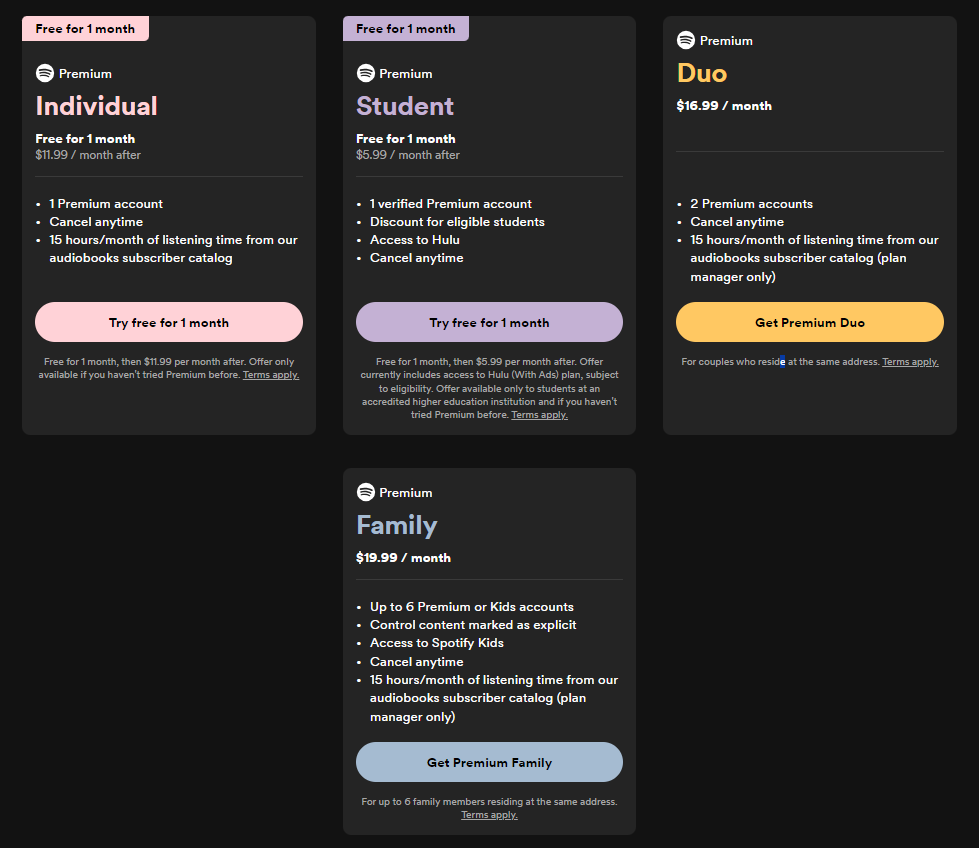
Unlike Spotify, Tidal doesn't offer a free tier. It starts at $10.99 per month for individuals. DJs can also add the DJ Extension to the Individual plan for $9 monthly to take full advantage of DJ software's Tidal integration and access over 110 million songs in lossless quality on Tidal. In addition to standard subscriptions, Tidal offers some special packages. For example, students can get a 50% discount on a subscription ($4.99 monthly). There is also a family package (up to a maximum of 6 users), which costs $16.99 monthly.
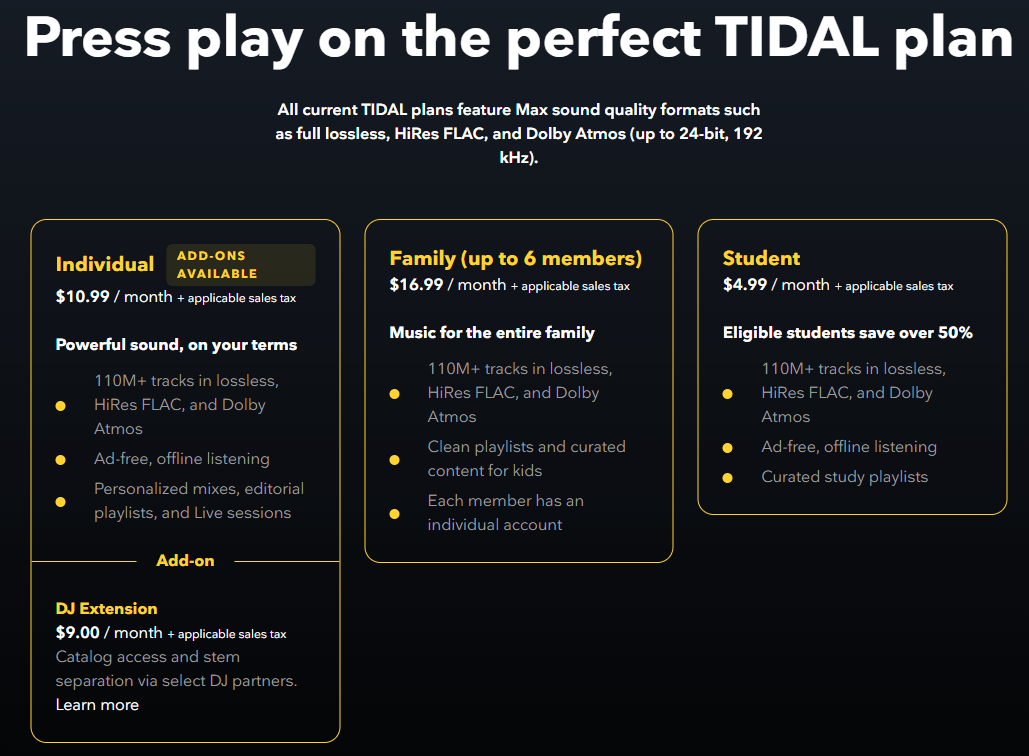
Verdict: Tidal vs Spotify, which is better? Both Tidal and Spotify offer a free trial to new customers, but it won’t last. You have several options in terms of pricing on both services, letting you dial in exactly how much you're willing to pay for streaming music. The free tier on Spotify is one of the better options for users who don’t mind ads and sound quality.
🔹There are other tricks you can try to block Spotify ads aside from upgrading to Spotify Premium, such as getting a reliable ad blocker. However, it may be against Spotify's terms of service. Users who violate the terms of service may have their accounts suspended or terminated.
Tidal vs Spotify, which has better sound quality? The most popular music streaming service for audiophiles, Tidal gives you the best sound quality options for your money. Tidal has a substantial library of spatial audio tracks in both Dolby Atmos and Sony 360 Reality Audio formats. Tidal also comes with three streaming quality settings: Low, High, and Max. All current Tidal plans feature all sound quality formats. Here are sound quality settings you can choose on Tidal:
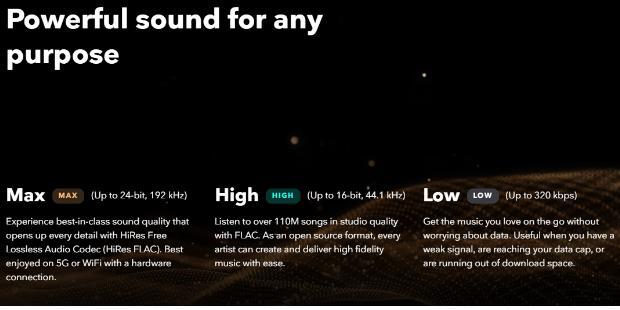
With Free Spotify, the maximum bitrate you can stream is 128kbps on the web player and 160kbps on the mobile and desktop apps. Spotify Premium plans also offer different sound quality settings, but the maximum streaming quality is Ogg Vorbis at 320kbps, which is the same as Tidal’s Low setting.
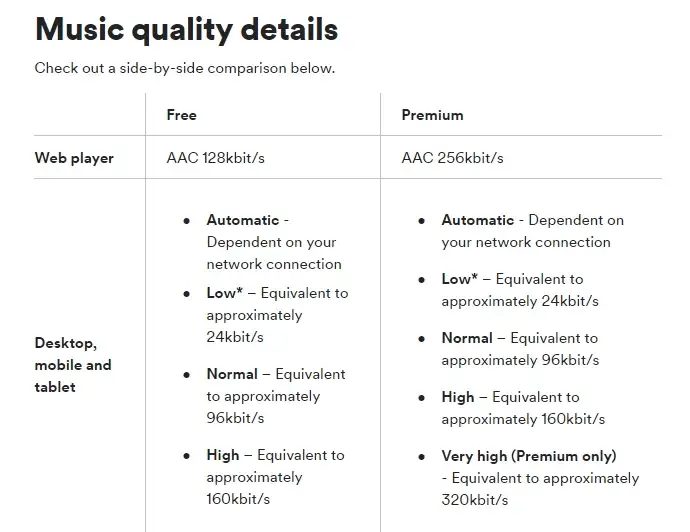
Verdict: Spotify announced a HiFi tier years ago, but there’s still no word on a release date. But Tidal can take your listening experience to a higher level with its superior audio settings and masters of sound quality. If you're looking for a stunning sound, choose Tidal.
Tidal vs Spotify, which has better content? Spotify has a catalog of 100 million tracks from around the world, and Tidal one-ups that number 110 million songs. Although there’s a ton of overlap in terms of available artists and albums, both services have their own flavor.
Spotify offers a bit more for niche tastes, with anime and video game soundtracks. Spotify also has been steadily adding other audio content for a while now. First, they added podcasts, and most recently, audiobooks. If you subscribe to Spotify Premium, you automatically get access to a massive library of audiobooks as part of your subscription. Spotify has a lot of hot newer releases like Britney Spears’ memoir and Ali Hazelwood’s latest novel, which is pretty impressive.
Tidal tends to be focused on larger artists, to the point where it offers a number of early exclusives from the big names, Beyonce’s Lemonade launched first on Tidal before expanding to other platforms. Tidal also features a selection of music and art-related podcasts to enjoy alongside its musical offerings.
Verdict: Spotify and Tidal are equal in terms of the amount of music content. But Spotify offers more variety with podcasts and audiobooks, so, choose Spotify first if you prefer to listen to podcasts and audiobooks.
Tidal comes as both a mobile and web application. Apple users can download it to their iOS (iPhone, iPad) or OSX devices (MacBook, Mac desktops) via the App Store. Android users can do the same through Google Play. There’s even a PC version available for download in the Microsoft store to use on Windows-operated machines. A plethora of devices also support Tidal, including many wireless speakers, smart TVs, and smartwatches. Mercedes-Benz owners are also able to stream Tidal content at the highest quality through the Mercedes me Portal by way of Bluetooth or the Mercedes me Adapter (for models built after 2002 without connected functionality).
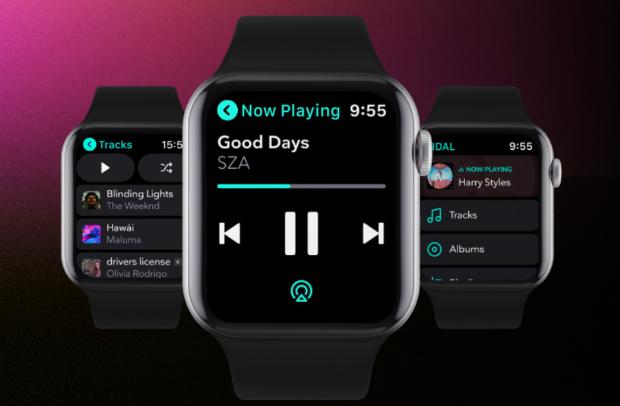
Part of Spotify's success is its ubiquity. You can access Spotify by launching the web player, downloading the desktop apps (available for Chromebook, Linux, Mac, and Windows), or installing the mobile app (available for Android and iOS). You can also find Spotify on TVs, set-top boxes, smartwatches, and home video game consoles. Spotify is also compatible with Apple Carplay and Android Auto so long as your car has that functionality.
Verdict: Tidal's support for more common devices like game consoles or the Roku platform is more anemic. Spotify not only has the major platforms covered, but there are also very few connected audio devices the service doesn’t support.
There are several features worth checking out on the platform. For instance, Tidal Connect allows you to instantly pull up the service on wireless speakers for hi-res playback over Bluetooth, AirPlay, or Wi-Fi. Following a March 2024 update, users can share universal links to songs or albums, allowing them to open those tracks in whatever service they use for listening to music. This is a significant step and means Tidal users can share their favorite new song with Spotify or Apple Music users and recipients will be able to open that song on their favored streaming platform. Now that's neat.
Plus, Tidal’s Live feature allows users to create a session and curate a playlist everyone can listen to. You can then share the link to your live session with your friends to enjoy music together. Alternatively, you can join existing live sessions to share music hosted by other users.
What extra features does Spotify provide? Here are some notable ones:
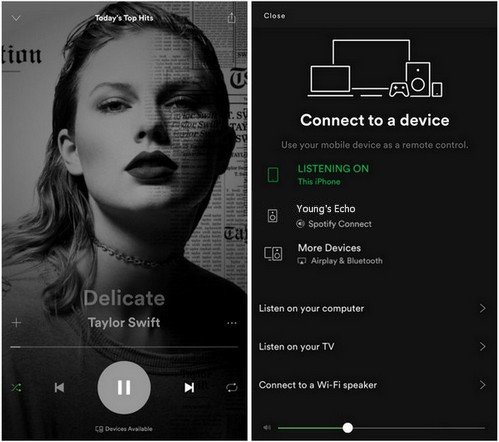
Verdict: Tidal vs Spotify, which is better? Spotify allows you to play local files. If you still have MP3 files saved to your computer from the old days and want to be able to listen to them in the same media player as your streamed music, you should get Spotify. Tidal doesn’t allow any local file playback, which is a shame for listeners with vast local libraries.
Tidal vs Spotify, which streaming service should you subscribe to? There is no such thing as a perfect streaming service, but Spotify comes closer than most. For free or paying, it includes a large catalog of audio-based entertainment and is more than enough for the needs of most people. On the other hand, if you don't want to pay to download podcasts and songs, DumpMedia Spotify Music Converter is an excellent alternative.
DumpMedia Spotify Music Converter is a powerful tool that lets you batch convert original-quality Spotify songs/playlists/albums/podcasts into MP3, WAV, FLAC, AAC, and ALAC after removing DRM from Spotify. Likewise, it can also keep all ID3 info of Spotify content for you and efficiently convert what you need up to 35X speed. Better yet, this program works with all Spotify Free and Premium subscribers! It means that you can listen to Spotify offline for free!
Here's how to listen to Spotify offline without Premium using DumpMedia Spotify Music Converter.
Step 1. Once the installation is complete, launch the DumpMedia Spotify Music Converter. Click the "Open the Spotify web player" button and process the account login to get into the web player right away. Drag the music you desire to download to the "+" on the right side of the converter.
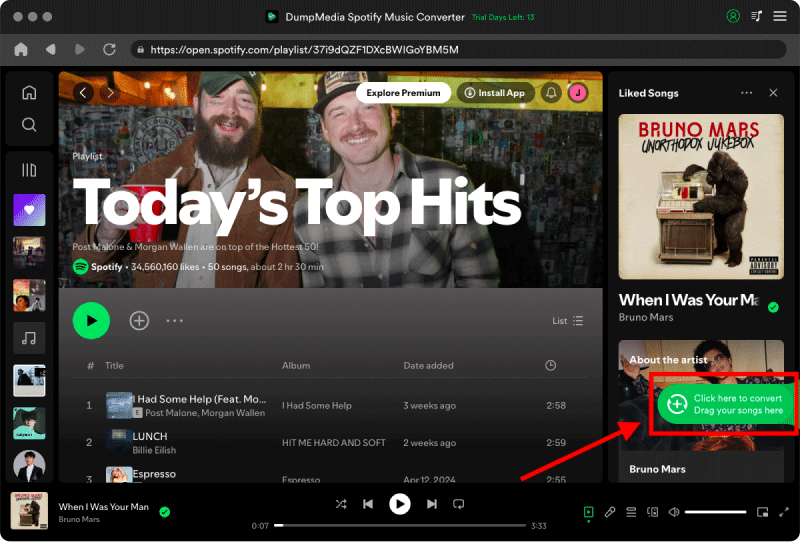
Step 2. Customize the file format, bitrate, sample rate and other output settings. As for the file format, DumpMedia offers several popular file formats. Here we recommend choosing MP3 as the output format.
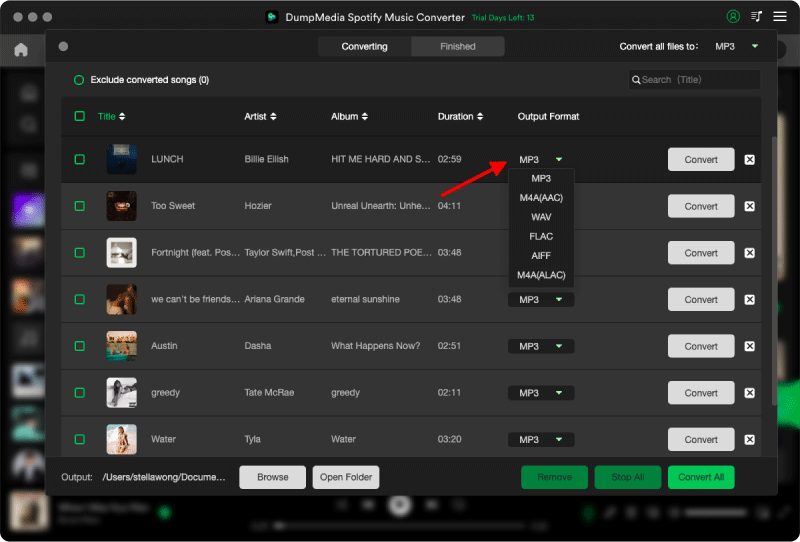
Step 3. Click the "Convert" button to start conversion. Once the conversion is finished, all the Spotify songs you selected in Step 2 will have already been converted and downloaded to the output folder you set in the previous step.
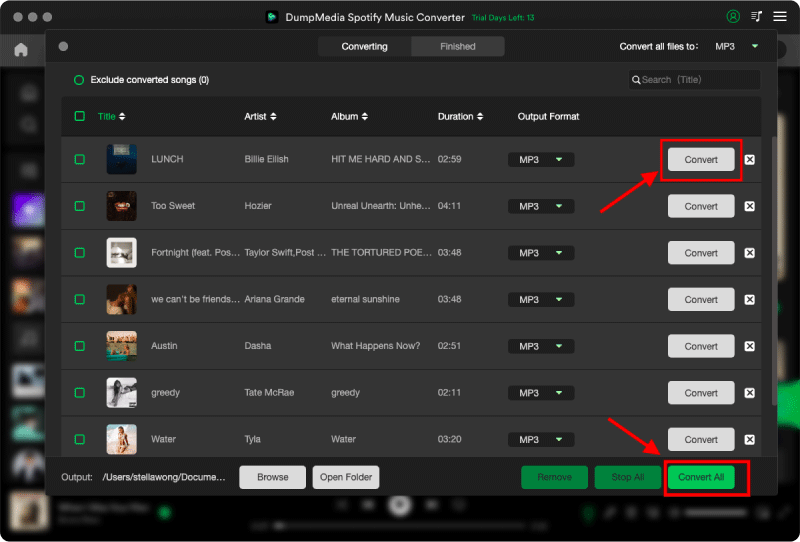
Tidal vs Spotify, how to choose the best music streaming service for you? Selecting Tidal or Spotify depends on several factors, such as sound quality, library size, features, etc. You should also think about the budget. The best choice is widely considered to be Spotify. It offers a vast music library, a user-friendly interface, and personalized playlists. Its extensive features and social integration make it a popular choice among users. It offers good sound quality, too, but would be best suited to casual listeners. Give DumpMedia Spotify Music Converter a try if you decide to choose Spotify. This best partner with Spotify allows you to download any content without Premium. Now, download and try it out at once.
